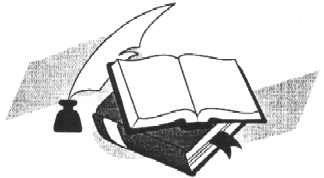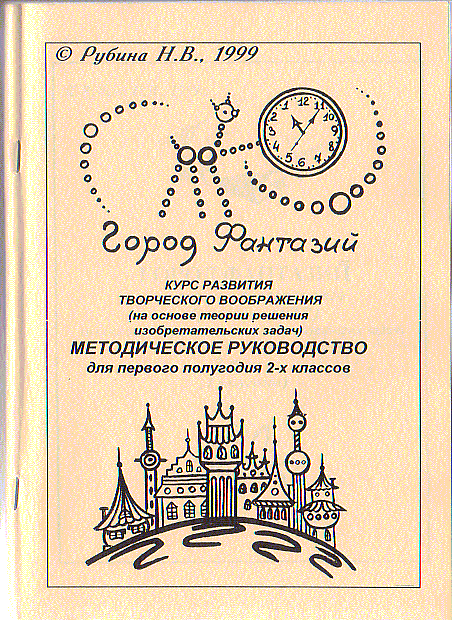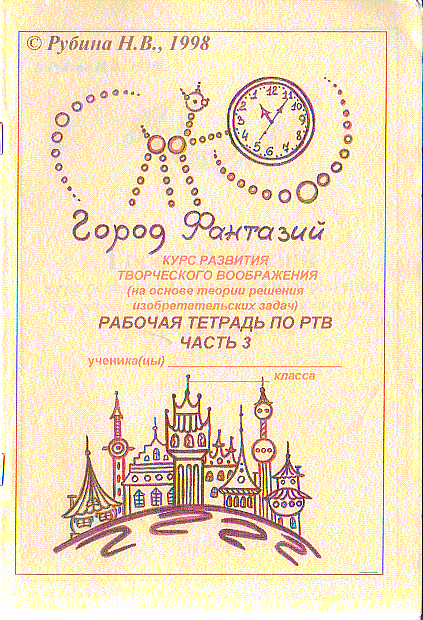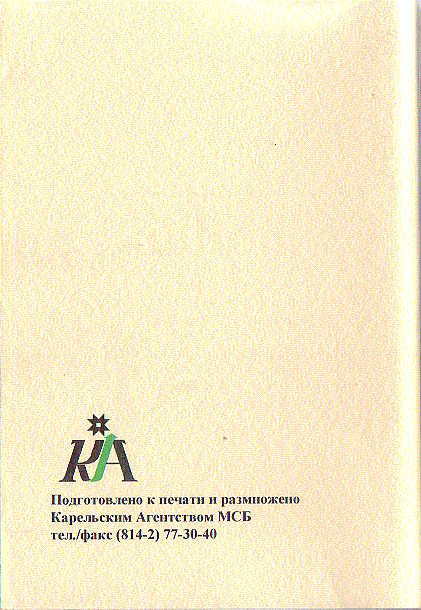 TRIZ
Textbooks: CID Course for Children, 2-1 W TRIZ
Textbooks: CID Course for Children, 2-1 W |
  
|
Fantasy
City:
Course
of Creative Imagination Development (CID), 2nd Grade, 1st Semester,
Workbook |
Natalia
V. Rubina (Petrozavodsk, Russia) 1998 [published
in Russian]
English
translation by Irina Dolina
(Tokyo, Japan) April 2, 2001
Technical
Editing by Toru Nakagawa
(Osaka
Gakuin Univ.) July 15, 2001 |
Published
in this "TRIZ Home Page in Japan" in English on Jul. 17, 2001 under the
permission of the Author.
(C) N.V.Rubina,
I. Dolina, T. Nakagawa, 2001 |
List of posting in this
Home Page:
| Jul. 17, 2001 |
2nd Grade/1st
Semester "Fantasy City" |
whole volume |
Guide-Book |
Workbook |
Editor's Note:
Please refer to the Editor's Preface (by T. Nakagawa) and the Author's
Preface (by N. V. Rubina) on the top page of this Course textbook series.
Contents
of the CID Course, 2nd Grade, 1st Semester Course
Top Page: 
(C) N. V. Rubina, I. Dolina and T. Nakagawa 2001
FANTASY CITY
The Course of Creative
Imagination Development
(on the basis of
Theory of Inventive Problem Solving (TRIZ))
WORKBOOK
Second Grade
First Semester
Student Name: ________________________________________________
Class: ________________________________________

FANTASY CITY
The Course of Creative
Imagination Development
(on the basis of
Theory of Inventive Problem Solving (TRIZ))
WORKBOOK
Second Grade
First Semester
(Part 3)
Natalia V. Rubina
Petrozavodsk 1998
English Translation by Irina Dolina, April
2, 2001
Technical Editing by Toru Nakagawa, July
15, 2001

PREFACE
We live in a rapidly changing world.
Bare knowledge like a frozen copy of the past, can not fully help us to
solve the arising problems. An ability to solve creative problems,
an advanced imagination are the qualities that mostly define a personality
not only of tomorrow but of today, as well.
On the basis of Theory of Inventive Problem
Solving (TRIZ) the author of this book has worked out and tested "The Program
of the Course of Creative Imagination Developing for the elementary school".
The controlled imagination allows a person faster and simpler to adapt
himself to changing conditions, therefore the CID course is actively used
by psychologists for diagnostics and psychological correction of elementary
school students.
In order to simplify the work on this program
a student book and a workbook were prepared to be presented here.
The whole program is meant for three grades:
"Fairy Tale School" - first grade; "The Fantasy City" - second grade;
"The Planet of Unsolved Mysteries" - third grade. This program was
used to instruct the kids of the first to the third grades of School No.
17 in the course of 6 years. The classes were conducted once a week;
the classes were divided into two groups. The program was conducted in
a few schools (the CID classes are being held by the elementary school
teachers at schools No. 17 , No. 43 and others).
The author expresses her deep gratitude to
I. N. Murashkovska, A. N. Nesterenko, M. C. Gafitulin, Sergey and
Svetlana Sychovs, N. N. Khomenko, V. I. Timohov, Anatoly and Svetlana Gin,
M. S. Rubin, whose works helped a lot in creating the CID course and the
workbooks. And of course the help of the first - third grade students
of School No. 17 of Petrozavodsk was very valuable. Thank you, my
dear little magicians!
Your comments and suggestions please send to
the following adress: 185014 Petrozavodsk, a.ya. 8 OO “TRIZ-Karelia”,
Rubina N. V.
 |
Hello,
dear children and dear adults! |
Do you remember that the city of your childhood
was full of sun, birds’ singing, warm and loving smiles? In this
city there were fairy tales: kind kings, beautiful princesses, noble knights…
You couldn’t stop being surprised – the world around you was changing all
the time. One day doesn’t resemble the other. It was very interesting
to find out how this amazing world was constructed!
To find out how his toy is constructed, a child
disassembles it (at your place you probably have many disassembled toys).
But the world is too large to disassemble it and to understand how it is
built. Let’s try together to learn how to change the world around
us, first mentally to understand it.
Sometimes there are arguments: “Imagination
and fantasy are given to a person by Nature and to help the child to design
his own world is the same as to teach a bird to fly!” Of course,
natural abilities are an amazing gift. However, think: who will fly
further – a person using only his natural abilities or a sportsman using
a spring-board?
Methods of developing imagination are like
a “spring-board” for the fantasy! Using these methods helps not to
waste time on fruitless tests, to feel unusual world outside the framework
of stereotype, outside the borders of mental inertia.
“To think and to do, to do and to think...”
Let these words of great Goethe be your slogan during your trip around
Fantasy City.
The author expresses deep gratitude
to the author of TRIZ G. S. Altshuller, also to I. N. Murashkowska, A.
A. Nesterenko, M. S. Gafitulin, M. S. Rubin, I. L. Vickentyev, N. N. Khomenko,
V. I. Timohov, S. V. Sychov and to other TRIZ-CID professionals, whose
works have contributed in preparing this CID Course. And, of course,
the contribution of the 1-3 grade students of School No. 17 of Petrozavodsk
is invaluable. Thank you, my little magicians!
Send your comments, suggestions and applications
for workbooks and methodical guide-books on CID course to the following
address:
185014 Petrozavodsk, mail box 8, OO ”TRIZ-Karelia”.
Rubina N. V.
.
Last updated
on Jul. 17, 2001. Access point: Editor: nakagawa@utc.osaka-gu.ac.jp




